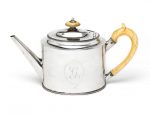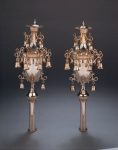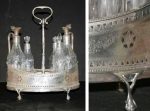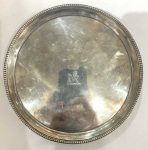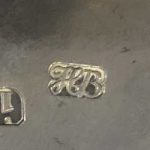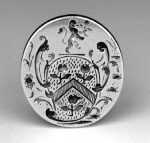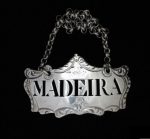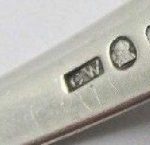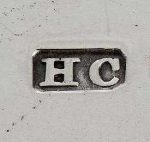Hester Bateman was the most prominent member of the famous Bateman family of silversmiths. She is often referred to as the ‘Queen of English Silversmiths’. In 1732 she married John Bateman, a maker of watch chains. Using the new techniques that became available in her days and well aware of the demands of the expanding silver market, she was instrumental in the establishment of a strong and expanding family business near London. Upon the death of her husband in 1761 she registered her own maker’s mark. Her work is generally characterized by refined shapes, with restrained decorations, often limited to beading on the edges. This characterization fits the 1780 Rimmonim offered for sale here, in which a plain neo-classical form predominates the carefully restricted decoration, largely consisting of beaded lines along the edges. Hester Bateman was also known as one of England’s foremost bright-cut engravers. Upon her retirement in 1790, she handed over the business to her sons, Peter and Jonathan. Other prominent silversmiths of the Bateman family were Hester’s daughter-in-law Ann, her grandson William and her great-grandson William Jr.
Hester Bateman is known to have produced one other important piece of Judaica, being a 1781 Sabbath Lamp (illustrated in M. Clayton’s Collector’s dictionary of the silver and gold of Great Britain and North America (1971). Reference: Christie’s
A George III silver tea pot by Hester Bateman, London 1782 Oval form with bead rims, the cover with flush hinge, ivory finial and handle, length 26.5cm, weight total 17.5oz.
Sold for £ 1,250 inc. premium at Bonhams in 2018
A Pair of Magnificent George III Silver Rimmonim made for the Great Synagogue of Portsmouth, England. Maker’s mark of Hester Bateman, London, 1780. Each set on a plain tapering stem with foliate knop and beaded bands at the edges, the raised upper part of the stem and the vase-shaped body decorated with beaded fluted foliage and palmette leaf bands, the sixteen partly reeded domed bells each suspending from a scrolled foliate bracket, the rised top surmounted by a crown decorated with geometrical and beaded bands, triangular spreading leaves and baluster finial. 42.5cm. (16 1n.) high 1974gr. Exhibited: Victoria and Albert Museum, London, Anglo-Jewish Silver, An exhibition of Jewish ritual silver and plate associated with the Jewish community of England. 10 may – 9 july 1978, catalogue nr. 43 (lent by the Portsmouth and Southsea Hebrew Congregation). Catalogue of an exhibition of Anglo Jewish Art and History In commemoration of the tercentenary of the resettlement of the Jews in the British Isles. Victoria and Albert Museum, London, 1956, catalogue nr. 193 (lent by the Portsmouth and Southsea Hebrew Congregation).
Sold for NLG 643,610 at Christies in 1999
George III Silver Cruet Stand Hester Bateman, London, circa 1789-90 Of oval form, with a beaded rim and central handle, bright cut with flowering garlands enclosing five silver mounted cut glass bottles, raised on claw and ball feet. Length 8 inches, approximately 20.2 ounces. Literature: David S. Shure Hester Bateman, 1959, pl.XVI Hebrew Congregation of St. Thomas
Sold for $1,500 (includes buyer’s premium) at Doyle New York in 2003
Hester Bateman 18th century sterling salver, 7.5 t.oz, D; 6.5 inches.Date letter i for 1784 as the year of manufacture.
Sold for $600 at David Killen Gallery in 2018
Hester Bateman silver makers mark
Heraldic Seal English (London) about 1780 Marked by Hester Bateman (1708–1794)
The seal is cut into an oval form and mounted with a cast openwork handle.
Reference: Museum of Fine Arts Boston
A George III silver basket, Hester Bateman, London, 1778 oval with beaded rims, pierced with horizontal and vertical slats above a scrolling frieze, beaded swing-handle 33.7cm., 13 1/4 in. long 769.5gr., 24oz. 14dwt.
Sold for 3,000 GBP at Sothebys in 2017
Bottle ticket with the word MADEIRA. Silver, shaped oblong with scrolled edges and chain attached by Hester Bateman circa 1790
Reference: © Victoria and Albert Museum
